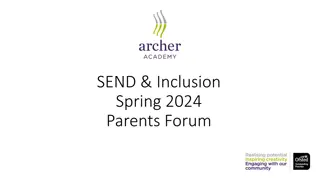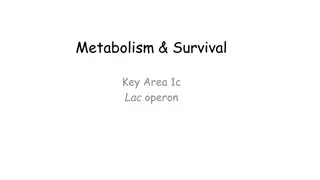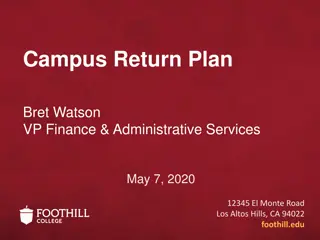Supporting a Successful Return to School for LAC: Strategies by Educational Psychologists
Educational psychologists Carol Booth, Jen Shannon, and Kate Hodgson share valuable insights on supporting a successful return to school for Looked After Children (LAC). Their SWAN model emphasizes safety, nurturing, welcoming, and unity. Strategies include safety planning, therapeutic stories, creating a welcoming environment, involving children in planning, and nurturing through play and connection.
Download Presentation

Please find below an Image/Link to download the presentation.
The content on the website is provided AS IS for your information and personal use only. It may not be sold, licensed, or shared on other websites without obtaining consent from the author.If you encounter any issues during the download, it is possible that the publisher has removed the file from their server.
You are allowed to download the files provided on this website for personal or commercial use, subject to the condition that they are used lawfully. All files are the property of their respective owners.
The content on the website is provided AS IS for your information and personal use only. It may not be sold, licensed, or shared on other websites without obtaining consent from the author.
E N D
Presentation Transcript
Supporting a successful return to school for LAC Carol Booth, Jen Shannon & Kate Hodgson Educational Psychologists - ESLAC
SWAN model Safety Nurturing Welcoming Returning to school All Together
Safety Familiarity wherever possible. Visual timetable - consistently referred to Expectations and boundaries - revisited and reiterated Safety procedures clearly shown (visually), talked through and modelled by all staff. Direct language to explain situations to students e.g. this is really hard to stay away from each other like this isn t it, but we will find a way to work through it Staff are regulated and feeling calm as they are modelling the response to this situation to their students Music and other rhythmic activities may be a calming and playful way to calm the brain stem and reduce the threat cues Safety planning: discuss and agree what the plan might be for days and times where school might feel overwhelming for the child and family. Where are the points of challenge throughout the day? How can we support here? Therapeutic story/social stories might be helpful
Welcoming How do we greet our young people when they arrive in our school and classroom? How does this make them feel? For those children and young people struggling to return how do we make connections and make them feel wanted? Take into consideration children/young experiences of the virus so far. How do we document/keep a record of these experiences? Make sure to be aware of any key information which may impact on their engagement/wellbeing in school. Ensuring you maintain check in opportunities.
All together Placing relationships at the centre Think about the message that the school is delivering as a whole what are these and how do all teachers deliver them? Students receive psychoeducation around Coronavirus and their questions are answered we use guidance to support such conversations How can children be involved in planning what happens during some of their day? Many children will be feeling anxious giving them some control over their day through choices is a way of helping them feel calmer. Think about all the small choices they can make during the day e.g. colour of pen, which worksheet etc. Although social distancing can make it difficult for us to be physically closer we prioritise connections with others and find ways to promote this despite social distancing e.g. engaging in playful activities and using the outdoors
Nurturing We spend time playing and reconnecting as a priority! Staff prioritise nurture as a key aim for the classroom Find specific times during the school day where students have the opportunity to explore their feelings in a safe environment with trusted adults to help them understand and process how they and their peers are feelings E.g. creative activities or circle time Talk about sadness as well as the things we appreciate, this enables young people to begin to process some of their feelings e.g. through collage, music, poetry and discussion Children have the opportunity to leave the classroom if they become overwhelmed. Staff use principles such as emotion coaching to guide discussions and support. Students have a number of movement breaks throughout the day Think about developing a bespoke package/curriculum for children who find it challenging to transition back, using their strengths and interests as a springboard to progress from
Put your oxygen mask on first In order to be able to recognise and respond to what children and young people need we must be able to recognise and respond to our own needs.
Activity what are you doing to look after you?
Helpfulresources https://www.place2be.org.uk/our-services/services-for-schools/mental-health-resources-for- schools/return-to-school-resources/ - A set of excellent resources for both primary and secondary which give ideas for activities according to a set of helpful principles similar to the SWAN model. https://www.annafreud.org/media/11727/managing-transition-back-to-school-jun2020.pdf - a helpful document to support returning to school. The Anna Freud website has lots of helpful resources around a range of key wellbeing issues. https://www.babcockldp.co.uk/babcock_l_d_p/Core-Downloads/Covid/Back-to- School/vlog5/Guidance-for-Developing-Relational-Practice-and-Policy.pdf - Excellent recent policy document which outlines the importance of relational policy and practice (which is key for LAC) and gives guidance around how to implement this in schools. https://www.aep.org.uk/recovery-re-introduction-renewal/ Us! Please do seek support from the ESLAC team should you be concerned about any of your LAC or PLAC students and we will do our best to support.























